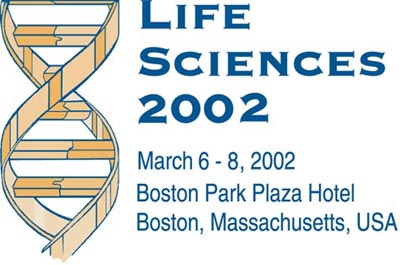

Please check the Final Program for the most recent changes in the schedule or room locations
Sponsored by the SIAM Activity Group on the Life Sciences
Held jointly for the first time with the
First SIAM Conference on Imaging Science
March 4-6, 2002
The life sciences have become increasingly quantitative as new technologies facilitate collection and analysis of vast amounts of data ranging from complete genomic sequences of organisms to satellite imagery of forest landscapes on continental scales. As a consequence, mathematics and computational science have become crucial technologies for the study of complex models of biological processes.
The new SIAM Activity Group on the Life Sciences brings together researchers who seek to develop and apply mathematical and computational methods in all areas of the life sciences. This inaugural conference of the activity group will provide a cross-disciplinary forum for catalyzing mathematical research relevant to the life sciences. It will facilitate rapid diffusion of new mathematical and computational methods in the life sciences, and may stimulate more researchers to work in these important areas. Mathematicians, life scientists, computational biologists, bioengineers and others interested in mathematical and computational analysis of biological systems are encouraged to attend.
This conference represents the first official function organized by this new SIAG. SIAG/LS and the newly formed SIAG on Imaging Science (SIAG/IS) were both created in recognition of the fact that the mathematics community should participate more directly in these non-traditional areas. Since these two activity groups have such a strong overlap in the area of biomedical imaging, this conference has been scheduled to overlap with the Conference on Imaging Science, chaired by David C. Wilson, set for March 4-6, 2002.
James Collins (Chair), Boston University
Carson Chow, University of Pittsburgh
Bijoy Ghosh, Washington University
Kevin Hall, Entelos, Inc.
Wing Hung Wong, University of California, Los Angeles
Clem Karl, Boston University
Denise Kirschner, University of Michigan, Ann Arbor
Mark Lewis, University of Utah
Martin Nowak, Institute for Advanced Study
Sharon Nunes, IBM Computational Biology Center
Tamar Schlick, Courant Institute of Mathematical Sciences, New York University
Rai Winslow, Johns Hopkins University
SIAM and the Conference Organizing Committee wish to extend their thanks and appreciation to the Air Force Office of Scientific Research (AFOSR) and the Department of Energy for their support of this conference.
The themes of the 2002 conference will include, but are not limited to:
SIAM and the conference Organizing Committee are proud to announce that the following mathematicians and scientists have accepted their invitations to speak at the conference. These invited speakers and their presentations will play an important role in increasing interaction among mathematicians, engineers, physicists, and researchers and scientists in academia, industry, and government who attend the meeting.
Wednesday, March 6
8:30 AM - 9:30 AM
IP1 Functional Imaging in Space and Time
Bruce R. Rosen, Harvard Medical School
1:00 PM - 2:00 PM
IP2 A New Dimension to DNA Sequence Analysis
Wilma K. Olson, Rutgers University
4:45 PM - 5:45 PM
IP3 Bringing the Genome to Life
Mark Boguski, Rosetta Inpharmatics, Inc.
Thursday, March 7
8:30 AM - 9:30 AM
IP4 Spatio-Temporal Pattern Formation in Neuronal Networks
G Bard Ermentrout, University of Pittsburgh
1:00 PM - 2:00 PM
IP5 Mathematical Models of Progression and Therapy of the HIV Infected Immune System
Glenn Webb, Vanderbilt University
4:45 PM - 5:45 PM
IP6 A Mathematical Approach to the Self-nonself Problem of Immunology and T-Cell Repertoires
David Rand, University of Warwick, United Kingdom
Friday, March 8
8:30 AM - 9:30 AM
IP7 The Mechanism and Dynamics of Defibrillation
James P. Keener, University of Utah
1:00 PM - 2:00 PM
IP8 Transformation of the Life Sciences Through Deep Computing
William Pulleyblank, IBM T.J. Watson Research Center
The purpose of the SIAG/Life Sciences is to foster
The life sciences have become quantitative as new technologies facilitate collection and analysis of vast amounts of data ranging from complete genomic sequences of organisms to satellite imagery of forest landscapes on continental scales. Computers enable the study of complex models of biological processes. The SIAG brings together researchers who seek to develop and apply mathematical and computational methods in all areas of the life sciences. It provides a forum that cuts across disciplines to catalyze mathematical research relevant to the life sciences and rapid diffusion of advances in mathematical and computational methods.
© 2000 Society for Industrial and Applied Mathematics
Designed by Donaghy's Web Consulting
Created 10/25/00; Last Updated 1/21/02 DAR